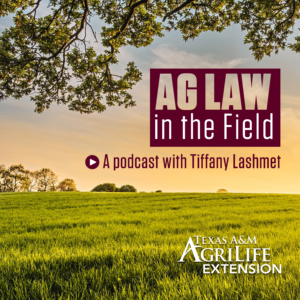Over the last month, there have been a large number of agricultural-related opinions released here in Texas. I plan to blog on each of these individually, but many of you have asked for some basic information about several of the opinions. Today, I will be giving brief summaries of the cases and links to read the full opinions for those of you who may be interested in doing so. Stay tuned over the next couple of months to see much deeper dives into the decisions in each of these cases and how it may impact you!

Photo by Ashlee Attebery on Unsplash
Hlavinka v. HSC Pipeline Partnership, LLC, No. 01-19-00092-CV (Court of Appeals for the First District of Texas, June 18, 2020). [Read full opinion here.]
This case involved HSC’s condemnation action against Texas landowners, the Hlavinkas, who own approximately 15,000 acres in Brazoria County. When HSC prepared to build a pipeline to transport propylene from Texas City to a plant in Brazoria County, it sought a 30-foot easement across the Hlavinka property. The parties could not reach an agreement on the terms of the easement and HSC filed a condemnation proceeding.
The Hlavinkas challenged HSC’s eminent domain power, arguing the pipeline would not transport crude petroleum or an oil product or liquefied mineral, as allowed by common carrier statute. Alternatively, even if a line transporting propylene was covered by the statutes, they argued this line was not for “public use” as required for eminent domain to be used. The trial court sided with HSC. The Hlavinkas appealed.
The Houston [1st Dist.] Court of Appeals affirmed in part and reversed in part. The court found that propylene is an “oil” product for purposes of Texas Business Organizations Code Section 2.105, which authorizes the use of eminent domain. Next, the court held that HSC failed to satisfy the “reasonable probability” test required for common carrier pipelines to satisfy the public use requirement. Thus, summary judgment was improper. Specifically, the court noted that the evidence HSC entered into a contract with Braskem, an unaffiliated third-party shipper who would retain title to the product at all times through the pipeline and at whose plant the product would be delivered “is not conclusive evidence of public use.” Testimony showed the purpose of the pipeline was to provide propylene to Braskem’s plant, there were no plans to add any other connections, and insufficient evidence of active marketing of pipeline resources to other suppliers of propylene in the area.
The case was remanded to determine whether HSC was a common carrier. Essentially, the court held that HSC did not provide enough evidence to win on summary judgment, but that they did provide enough evidence to survive the Hlavanka’s plea to jurisdiction. Thus, the case will go back to the trial court to make a finding on this particular question based on the evidence presented.
Additionally, the court looked at an evidentiary question of whether testimony of fair market value that used per rod prices as a factor, but not the sole evidence, was permissible, and found that this testimony should have been admitted.
Waak v. Zuniga, No. 19-0167 (Texas Supreme Court, June 12, 2020). [Read full opinion here; Read dissent here.]
You may remember the Waak case from this prior blog post. Mr. Zuniga worked for the Waaks helping with their cattle. In October 2013, he was killed while moving a bull, cow, and calf. The Waaks were non-subscribers under the Texas Workers’ Compensation Act. Mr. Zuniga’s family filed suit against the Waaks claiming negligence. The Waaks raised the Texas Farm Animal Liability Act as a defense. The trial court dismissed the case, finding the Act applicable, but the court of appeals reversed, holding that Zuniga “was not a participant in a farm animal activity” for whose death the Act limits liability. The Waaks appealed.
The Texas Supreme Court sided with the Zuniga family, finding the Texas Farm Animal Liability Act inapplicable to injured “ranchers or ranch hands.” The Court looked at the history of the Farm Animal Liability Act (and its predecessor, the Texas Equine Act), noting that there was no mention of “ranching” in the examples of what constitutes “participation in a farm animal activity.” Interestingly, the court did not draw any distinction between ranch workers who are employees versus those who are independent contractors, which was the focus of the court of appeals in its opinion. This case is extremely important and could have significant impacts on livestock owners, as it limits the scope of the Act further than previously understood.
Justice Blacklock wrote a dissenting opinion, which was joined by Justice Boyd. The Justices essentially made a textual argument, claiming the majority ignored the plain text of the Act as drafted by the legislature. “…Courts will decide when the statute’s word mean exactly what they say and when they mean something else. The unfortunate result is that people cannot simply read the Act–and others similarly drafted–and know what it means based on grammar and sentence structure. They must wait to see what courts make of it.”
Stratta v. Roe, No. 18-50994 (United States Court of Appeals for the Fifth Circuit, May 29, 2020). [Read full opinion here.]
A landowner, Mr. Fazzino, filed suit against the Brazos Valley Groundwater Conservation District (BVGCD) claiming the BVGCD allowed the City of Bryan to drain groundwater from beneath Fazzino’s property without compensation. Specifically, he alleged violations of the Equal Protections Clause and a taking of private property without just compensation. This dispute involves a well drilled on a 2.7-acre property owned by the City of Bryan that was permitted to produce 3,000 gallons per minute. Bryan’s property and well is next to Fazzino’s 26.65-acre property. After Fazzino was unsuccessful in his attempt to reduce the amount of water the City of Bryan was allowed to pump on their property pursuant to the BVGCD rules, he applied for a similar permit to drill a well producing 3,000 gallons per minute. His permit was rejected as he did not have the sufficient controlled acreage of 649 acres to drill a new well. Fazzino filed suit against BVGCD alleging unequal application of BVGCD’s rules as between Fazzino, whose permit was denied, and the City of Bryan, whose permit was granted despite even fewer acres than the City. The trial court dismissed the case. Fazzino appealed.
The 5th Circuit reversed. First, the court found that the BVGCD does not have sovereign immunity and the District may be sued in this situation. Second, the court found Fazzino’s claim was ripe as he had previously fully pursued all of the administrative remedies available to him prior to filing the ligation. Third, the court held that the trial court should not have abstained from hearing the constitutional law questions due to Burford abstention. Fourth, the court found that Fazzino alleged sufficient facts to support his equal protection and takings claims to survive a motion to dismiss. The court, in what is likely the most interesting portion of the opinion for Texas landowners, discusses the prior Texas case law regarding how oil and gas law applies to groundwater law. Finally, the court did uphold the dismissal of Mr. Stratta, who was a Board Member of the BVGCD, in which he alleged a violation of his First Amendment rights when he was not allowed to add an agenda item related to the Fazzino permit request at a meeting.
Bush v. Lone Oak Club, No. 18-0264 (Texas Supreme Court April 24, 2020). [Read full opinion here; Read dissent here.]
At issue in the case is ownership of portions of the Lone Oak Bayou, located near the Gulf of Mexico. In 1872, 160 acres, including the Lone Oak Bayou, was purchased by Sophronia Barrow. Chain of title has eventually passed to the Lone Oak Club. When members of the public began hunting and fishing on portions of the Bayou, a dispute occurred over the ownership of the Bayou’s submerged bed. The Club argues they own the submerged bed pursuant to the Barrow Survey, which includes the land under the water. The General Land Office took the position that any land located below the line of mean high water was owned by the State of Texas, rather than the Club. The key legal issue is whether the 1929 “Small Bill,” a Legislative action confirming and validating ownership of lands laying across water courses or navigable streams with patents and awards covering or including beds and banks of water courses or navigable streams, grants ownership of stream beds both above and below the tide.
The Supreme Court held that the Small Bill “validates patents conveying the submerged beds of navigable streams, whether above or below the tide line.” The Court noted that it believes this ruling will have “limited impact” as it will apply to very few properties. In order for the Small Bill to validate and confirm grants of ownership of navigable streams, there are four requirements: (1) patents and awards; (2) granted at least 10 years before the 1929 Small Bill; (3) lying across or partially across; and (4) watercourses or navigable streams–terms applying to only water features meeting certain criteria.
Finally, although the Court held that the Small Bill encompasses the beds of navigable streams both above and below the tide, it did not address whether the Lone Oak Bayou was considered a “navigable stream” or “watercourse” pursuant to the Small Bill. The case was remanded for that determination to be made.
Justice Green issued a dissent, which was joined by Chief Justice Hecht, arguing that this decision “departs from the long-standing distinction in Texas law between submerged land above the mean high tide and submerged land below the line of mean high tide.” The dissenters would hold that the State of Texas owns the beds of bodies of water below the line of mean high tide, including the submerged land in this case.
For a great blog post by Texas attorney John B. McFarland, click here.












